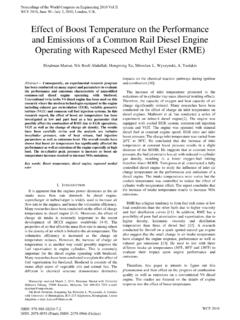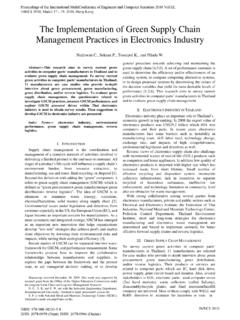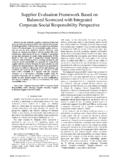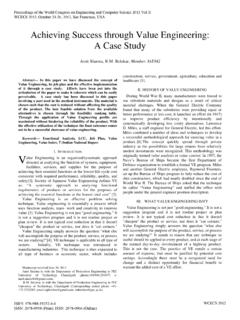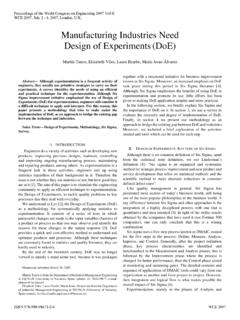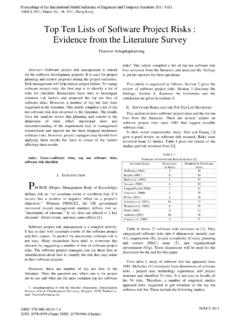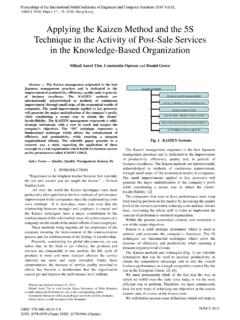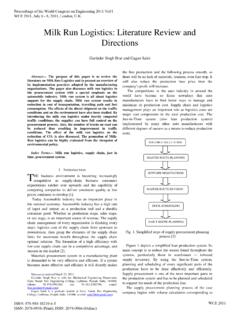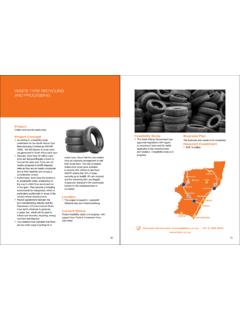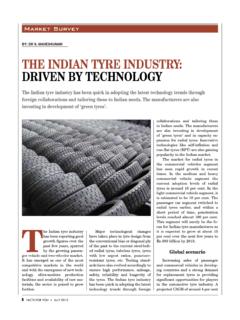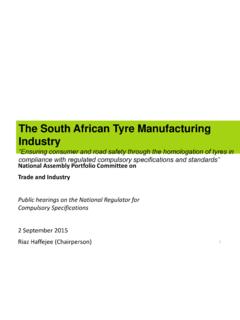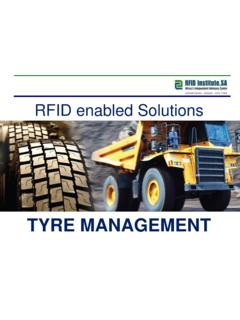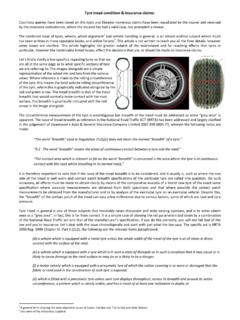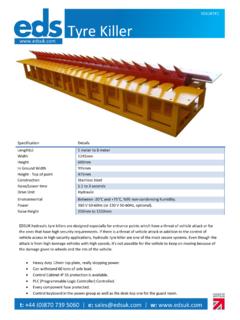Transcription of A Review and Discussion of Waste Tyre Pyrolysis …
1 Abstract This paper reviews and discusses the Waste tyre Pyrolysis process and the applications of the derived products. The primary and secondary applications of oil, char, gas and steel wires are discussed. The paper also reviews the influence of operating parameters such as feed size, temperature and residence time. An analysis of the Pyrolysis products market is also given. The study objectives were achieved through a triangulation procedure comprising of literature analysis, site visits and as well as personal and telephonic interviews.
2 The paper concludes by discussing the successes and failures of the Pyrolysis process. Index Terms Process parameters, product markets, Pyrolysis , triangulation procedure, Waste tyre I. INTRODUCTION PROLYSIS has been applied in the past to carbonaceous materials such as coal or wood. The ancient Egyptians practiced wood distillation by collecting tars and pyro ligneous acid for use in their embalming industry [1]. Pyrolysis of wood to produce charcoal was a major industry in the 1800s, supplying fuel for the industrial revolution.
3 Charcoal was used for the smelting of metals and it is still used today in metallurgy [2]. For thousands of years charcoal has been a preferred heating fuel until it was replaced by coal. In the late 19th century and early 20th century wood distillation was still profitable for producing soluble tar, pitch, creosote oil, chemicals, and non-condensable gasses often used to heat boilers. The wood distillation industry declined in the 1930s due to the advent of the petrochemical industry and its lower priced products.
4 However, Pyrolysis of wood to produce charcoal for the charcoal briquette market and activated carbon for water purification is still practiced in the United States of America (USA) [2]. Over the last 20 30 years, several laboratory, pilot-plant and even commercial attempts have been made to Manuscript received February 23, 2014 revised March 30, 2014. This work was supported the National Research Foundation, Council for Scientific and Industrial Research and the University of Johannesburg.
5 Nhlanhla. P. Nkosi is with the Department of Chemical Engineering, Faculty of Engineering and the Built Environment, University of Johannesburg, Doornfontein, Johannesburg 2028, (email: Edison. Muzenda is is a part-time Energy and Environmental Engineering Specialist the with Process, Energy and Environmental Technology Station as well as Professor of Chemical Engineering, Department of Chemical of Chemical Engineering, Faculty of Engineering and the Built Environment, University of Johannesburg, Doornfontein, Johannesburg 2028, Tel: +27115596817, Fax: +27115596430, (Email.))
6 Establish economical units for Pyrolysis of such materials for example; Kobe Steel in Japan, Tosco in the USA, Tyrolysis in the United Kingdom (UK), Ebenhausen in Germany and many more [3]. Pyrolysis is an endothermic process that induces the thermal decomposition of feed materials without the addition of any reactive gases, such as air or oxygen. The thermal efficiency of this process is approximately 70%, and can increase to 90% with the use of Pyrolysis products as fuel [4 ].
7 The use of tyre chips instead of whole tyres may also increase the efficiency of the process by 20-30% [5]. The thermal energy used to drive the Pyrolysis reaction is applied indirectly by thermal conduction through the walls of the containment reactor. Pyrolysis generally occurs at temperatures between 400 and 800 C [6]. As the temperature changes, the product distribution (or the phase of the products) are also altered. Lower Pyrolysis temperatures usually produce more liquid products while higher temperatures favour the production of gases.
8 The speed of the process and rate of heat transfer also influences the product distribution. Slow Pyrolysis (carbonization) can be used to maximize the yield of solid char. This process requires a slow pyrolytic decomposition at low temperatures. Rapid quenching is often used to maximize the production of liquid products, by condensing the gaseous molecules into liquid. In some Pyrolysis processes, a product up to 80% liquid by weight can be produced [3].
9 Hydrogen or steam can also be used in the Pyrolysis process to change the makeup of the product distribution. Hydrogen can be used to enhance the chemical reduction and suppress oxidation by means of the elemental oxygen in the feedstock. Steam can also be used as a pyrolyzing medium, allowing Pyrolysis to occur at lower temperatures and higher pressures. The use of water as a pyrolyzing media also allows the feedstock to be introduced into the reactor in an aqueous form.
10 An additional advantage of water or steam is that the resulting char has a relatively high surface area and porosity that is similar in nature to activated charcoal [2]. Nitrogen gas can be supplied to maintain the inert atmosphere in the reactor and also to sweep away the pyrolyzed vapour product to the condensers. Furthermore, purging the system with nitrogen assists to minimise secondary reactions in the hot zone [2]. Some of the problems related to the process are the high cost of the plant and residue treatment [5].
